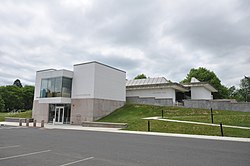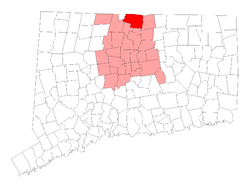History
Originally known as Southfield—pronounced "Suffield," on May 20, 1674, the committee for the settling of the town petitioned:
...that the name of the place may be Suffield, it being the southernmost town that either at present is, or like to be in that Countrey, and neere adjoining to the south border of our Patent in those parts. [ sic ]
The petition was granted by the Massachusetts Bay court on June 8, 1674. Suffield was incorporated as a town in March 1682. [3]
Also, on early 17th and 18th century maps, Suffield was alternatively spelled as Suthfield.
Suffield and the surrounding area were part of the Equivalent Lands compromise with Massachusetts in 1715–1716. [4]
Suffield's native and adopted sons include The Rev. Ebenezer Gay, a renowned Congregational minister; U.S. Postmaster General Gideon Granger; real estate speculator Oliver Phelps, once the largest landowner in America; composer Timothy Swan; architect Henry A. Sykes; sculptor Olin Levi Warner; Seth Pease, surveyor of the Western Reserve lands in Ohio, most of which were controlled by Suffield financiers and speculators; and Thaddeus Leavitt, [5] inventor of an early cotton gin, merchant and patentee of the Western Reserve lands. [6] Thanks to the town's early prominence and wealth, it boasts an astonishing collection of early New England architecture. [7] The Kent family, for whom the town's library is named, originated in Gloucester, Massachusetts, and boasted relations to many prominent early New England families, including the Dwight family of Northampton, Massachusetts, the Hooker family of Hartford, the Dudleys of Guilford, Connecticut, and the Leavitts of Suffield. [8] [9] Descendants of Robert Olds, who arrived from Sherborne, Dorset, in 1667, include automotive pioneer Ransom Eli Olds, Copperhead Ohio politician Edson Baldwin Olds, his great-grandson USAAF General Robert Olds, and his son, iconic USAF fighter pilot Robin Olds.
Slavery was common throughout the Connecticut River Valley during the 18th century, and the 1774 Census for the Colony of Connecticut listed 37 slaves in Suffield. Throughout the Connecticut Valley, wealthy merchants, tavern owners and town ministers owned slaves. When Major John Pynchon originally purchased from the Pequonnocks and Agawam tribes a six-mile tract of land, which he called Stoney Brooke Plantation, he first ordered the construction of a sawmill, and used two of his slaves, Harry and Roco, for the construction. [10] Suffield's third minister, Reverend Ebenezer Devotion, became minister in 1710, and "sixteen years later the town voted to give him £20 to purchase a slave. [11] Reverend Ebenezer Gay, Devotion's successor, owned six slaves throughout his long term, 1742–1796. Reverend Ebenezer Gay Jr. manumitted his family's three remaining slaves in 1812. They were Titus, Ginny and Dinah. [12] "Princess," a slave belonging to early Suffield settler, Lieut. Joshua Leavitt, died November 5, 1732. [13] Some of Leavitt's descendants became ardent abolitionists, including Joshua Leavitt and his cousin Roger Hooker Leavitt, who operated an Underground Railroad station in Charlemont, Massachusetts.
One of the earliest graduates of the Yale Medical School was one of Suffield's earliest physicians. Dr. Asaph Leavitt Bissell, born in 1791 at Hanover, New Hampshire, to parents originally from Suffield, [14] attended Dartmouth College, and later graduated in the second class of the Yale Medical School. Bissell moved to Suffield, where he rode horseback to make house calls on his patients. Bissell's saddlebags are today in the collection of the Yale Medical School's Historical Society. [15]
Geography
According to the United States Census Bureau, the town has a total area of 42.9 square miles (111.2 km2), of which 42.3 square miles (109.5 km2) is land and 0.69 square miles (1.8 km2), or 1.58%, is water. [16] The town center (Suffield Depot CDP) has a total area of 2.0 square miles (5.1 km2), all of it land.
Suffield is on the west bank of the Connecticut River, 8 miles (13 km) south of the river's largest city, Springfield, Massachusetts, and 16 miles (26 km) north of Connecticut's capital, Hartford. Two bridges span the river to the town of Enfield: the Amtrak/Springfield Terminal Railroad Bridge and the Enfield–Suffield Veterans Bridge.
The Metacomet Ridge, a mountainous trap rock ridgeline that stretches from Long Island Sound to nearly the Vermont border, runs through the center of Suffield from south to north as West Suffield Mountain. The 51-mile (82 km) Metacomet Trail traverses the ridge.
Demographics
Historical population| Census | Pop. | Note | %± |
|---|
| 1850 | 2,962 | | — |
|---|
| 1860 | 3,260 | | 10.1% |
|---|
| 1870 | 3,277 | | 0.5% |
|---|
| 1880 | 3,225 | | −1.6% |
|---|
| 1890 | 3,169 | | −1.7% |
|---|
| 1900 | 3,521 | | 11.1% |
|---|
| 1910 | 3,841 | | 9.1% |
|---|
| 1920 | 4,070 | | 6.0% |
|---|
| 1930 | 4,346 | | 6.8% |
|---|
| 1940 | 4,475 | | 3.0% |
|---|
| 1950 | 4,895 | | 9.4% |
|---|
| 1960 | 6,779 | | 38.5% |
|---|
| 1970 | 8,634 | | 27.4% |
|---|
| 1980 | 9,294 | | 7.6% |
|---|
| 1990 | 11,427 | | 23.0% |
|---|
| 2000 | 13,552 | | 18.6% |
|---|
| 2010 | 15,735 | | 16.1% |
|---|
| 2020 | 15,752 | | 0.1% |
|---|
|
As of the census [18] of 2000, there were 13,552 people, 4,660 households, and 3,350 families residing in the town. The population density was 321.0 inhabitants per square mile (123.9/km2). There were 4,853 housing units at an average density of 115.0 per square mile (44.4/km2). The racial makeup of the town was 88.67% White, 6.95% African American, 0.24% Native American, 0.94% Asian, 0.04% Pacific Islander, 2.03% from other races, and 1.13% from two or more races. Hispanic or Latino of any race were 4.25% of the population.
There were 4,660 households, out of which 32.8% had children under the age of 18 living with them, 62.2% were married couples living together, 6.9% had a female householder with no husband present, and 28.1% were non-families. Of all households, 23.3% were made up of individuals, and 11.6% had someone living alone who was 65 years of age or older. The average household size was 2.55 and the average family size was 3.04.
In the town, the population was spread out, with 22.1% under the age of 18, 8.0% from 18 to 24, 31.7% from 25 to 44, 24.1% from 45 to 64, and 14.1% who were 65 years of age or older. The median age was 39 years. For every 100 females, there were 116.9 males. For every 100 females age 18 and over, there were 121.1 males.
The median income for a household in the town was $66,698, and the median income for a family was $79,189. Males had a median income of $52,096 versus $35,188 for females. The per capita income for the town was $28,171. About 1.8% of families and 3.6% of the population were below the poverty line, including 2.5% of those under age 18 and 6.2% of those age 65 or over.










